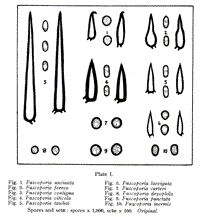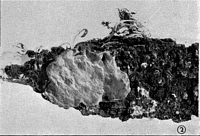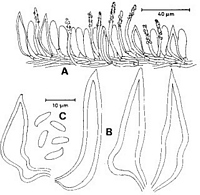|
 Phellinus tawhai Phellinus tawhai
SynonymsFuscoporia tawhai
Fomes salicinus
Polyporus salicinus
BiostatusPresent in region - Indigenous. Endemic
Images (click to enlarge) | 
Caption: Fig. 2. Fuscoporia tawhai, x1. Small hymeniphore showing the irregular surface. | 
Caption: Fig. 21. Phellinus tawhai. A, section through the hymenium with setae and projecting encrusted
hyphae; B, setae; C, spores. From the type of Fuscoporia tawhai (PDD 5509). |
Article: Buchanan, P.K.; Ryvarden, L. (1988). Type studies in the Polyporaceae - 18. Species described by G.H. Cunningham. Mycotaxon 31(1): 1-38.
Notes: There is a good description in Cunningham (1965: 229). The hyaline, cylindrical spores from the
type specimen measure 7-8.5 x 2-2.5 µm, somewhat larger than the dimensions given by
Cunningham (1965). As noted by Cunningham, Phellinus ferreus (Pers.) Bourd. & Galz. is closely
related but differs in being always adnate, never effused-reflexed nor with a black pileus surface as
in pileate forms of P. tawhai.
Article: Cunningham, G.H. (1948). New Zealand Polyporaceae. 2. The genus Fuscoporia. New Zealand Department of Scientific and Industrial Research, Plant Diseases Division, Bulletin 73: 14 p.
Description: Hymenophore obscurely stratose, linear when to one metre long, 5 cm. wide, 1-7 mm. thick,
or. irregularly orbicular when to 5 cm. diameter, with outlying orbicular islands; margin
lifting slightly, irregularly lobed, 1-2 mm. wide, finely pubescent, ferruginous, greyish when
old; surface uneven, nodose, often undulate, when fresh smoky grey or greyish brown,
becoming dull ferruginous to umber, and much creviced when old. Pores in two or three
obscure layers, each 1-2 mm. deep, ferruginous in section, round, 75-150 µ diameter, most
about 100 µ, or 5-7 per mm.; dissepiments equal, 50-400 µ thick, most 100-200 µ, apex
equal, finely velutinate with protruding hyphae usually coated with fine crystals. Context to 2
mm. thick, chestnut or ferruginous brown, densely woven, with abundant crystals; skeletal
hyphae 3-3.5 µ thick, lumen 1 µ, yellow-brown, aseptate, sparsely branched, somewhat
undulate; generative hyphae 2-3 µ thick, thin-walled, tinted yellow or hyaline, branched,
septate. Setae mostly subulate, a few ventricose, chestnut brown, 30-40 x 6-8 µ, most 30-32 µ
long. Basidial type honeycomb, basidia clavate, 8-12 x 4-5 µ. Spores cylindrical with rounded
ends, 5-6 x 1.5-2 µ, smooth, hyaline.
Habitat: HABITAT: On bark of fallen branches, dead branches attached to living trees, or upright dead
saplings, associated with an active white rot.
Distribution: DISTRIBUTION: New Zealand.
Notes: In microscopic features the species agrees closely with F. ferrea, possessing similar spores,
setae, skeletal and generative hyphae. It differs in the surface, colour and marginal characters
of the hymenophore, and especially in the smaller pores with thicker dissepiments. Pores are
75-150 µ diameter and dissepiments 50-400 µ thick, whereas those of F. ferrea are 100-200 µ
diameter, and 50-100 µ thick respectively. The plant is common on Nothofagus cliffortioides
in the National Park region, where it is associated with an active white rot of dead saplings
and branches of this host. Its specific name has been taken from the generic name tawhai
given by the Maori to most species of beech.
|